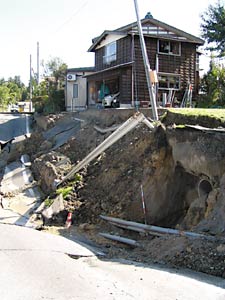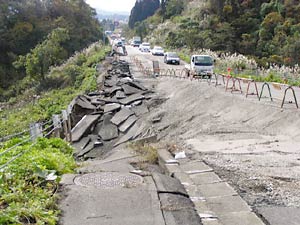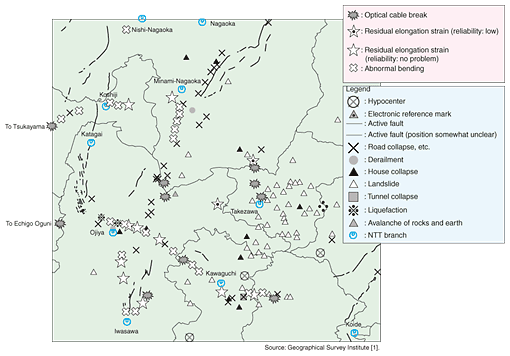 |
|||||
|
|
|||||
|
Special Feature on Technical Solutions to Real-world Problems Vol. 5, No. 7, pp. 14–16, July 2007. https://doi.org/10.53829/ntr200707sf4 Technology for Assessing Optical Cable Reliability after a DisasterAbstractIn disasters accompanied by major ground movement, such as the 2004 Niigata Chuetsu Earthquake, the reliability of telecommunications equipment with no perceptible damage should be assessed in parallel with the restoration of stricken facilities. This report introduces technology for assessing the reliability of optical cables after such a disaster.
1. Need for reliability assessmentThe Niigata Chuetsu Earthquake, which occurred on October 23, 2004, caused much damage to the social infrastructure, including great damage to telecommunication facilities, as shown in Figs. 1 and 2. This included damage to optical trunk line cables, the backbone for medium- and long-distance commu–nications, with breaks occurring at ten locations due to landslides and avalanches. At these locations, facilities were restored relatively quickly thanks to the efforts of maintenance engineers. Nevertheless, the restoration of services was no guarantee that these cables would not experience problems in the future. More than 300 km of optical trunk line cables were deployed in the stricken area, and most of them were underground cables, so there was no easy way to check them for damage from their external appearance. It was therefore decided to measure residual elongation strain and bending loss in the optical fibers remotely from an NTT central office as an efficient method for determining disaster-related damage in optical cable.
2. Assessment methodIn general, the application of a large force such as a tensile force to a material object tends to lower the strength of that object. The degree to which a force is being applied can be determined by measuring the residual elongation strain of the object in question. This residual elongation strain can be used to calculate the long-term reliability of optical fiber subjected to excessive tension. A Brillouin optical time domain reflectometer (B-OTDR) was used to perform the measurements making use of the following principle: When light passes through an optical fiber, the frequency of reflected light (Brillouin scattering) changes in proportion to the amount of strain in the optical fiber. Another characteristic of optical fiber is that transmission loss increases with bending. Since bending occurs when an external force is applied to the optical fiber, the location at which such an abnormal external force is being applied can be determined by finding where the cable is bent. Bending loss can be measured using a 3-wavelength (1.31, 1.55, and 1.65 µm) OTDR. This locates the bending position using the principle that bending loss is higher for longer wavelengths. 3. Assessment resultsWe performed measurements in March 2005, about four months after the earthquake, along 18 routes of optical relay cable deployed around the cities of Nagaoka and Ojiya and the town of Kawaguchi. These measurements revealed abnormal residual elongation strain at 10 locations and abnormal bending loss at 35 locations. The abnormal locations detected by these measurements as well as earthquake-related damage other than that to telecommunication facilities are shown in Fig. 3. Abnormal residual elongation strain tended to occur near landslides, collapsed roads, and so on. On calculating the probability of an optical-fiber fracture 30 years later based on the measured residual elongation strain, we found that eight of the ten locations having abnormal residual elongation strain had a probability of less than 10-6%, which indicates no problem. The remaining two locations, however, had a fracture probability of about 2% and 10% or greater, respectively, indicating reduced long-term reliability. It was therefore recommended that the cables at these two locations should be replaced just to be on the safe side.
As shown in Fig. 3, abnormal bending loss was found to be distributed over a wide area with a somewhat weak correlation with other damaged locations. In terms of earthquake-related factors, this bending loss is thought to be caused by (1) pulling on individual optical fibers due to excessive tension, (2) cable bending due to conduit offset, and (3) bending of individual optical fibers due to cable displacement at a closure. Non-earthquake-related factors are thought to be (4) poor handling of excess fiber when making connections, (5) operation of a water sensor module, and (6) bending due to optical fiber movement caused by vehicle-related vibration. Since it is difficult to determine which of these factors are the causes at abnormal bending locations detected by measurements, on-site checking of connection points and other cable components is required. If a sharp bend is detected, the cable should be uncovered and inspected. If damage to the cable or closure is then found, the cable should be replaced. 4. Hidden danger in unseen placesAs described above, an area stricken by a natural disaster may include locations where the long-term reliability of optical cable is reduced in addition to locations having obvious breaks or other types of visible damage. It is important that residual elongation strain and bending loss be measured as needed to check reliability even for optical cables having no transmission problems at present. Performing such a survey enables abnormal locations to be isolated and, considering that locations requiring on-site checking can be selected from an extensive survey route and priority assigned, it can increase the efficiency of facility inspections after a disaster. It must also be kept in mind that unexpected abnormalities that could not be caught by an initial survey may still show up later in optical cables deployed in a stricken area. This possibility makes it all the more important to step up regular monitoring to maintain reliability in telecommunication facilities. The technology presented here is not limited to assessing the reliability of optical cables affected by an earthquake. It can also be used to assess the reliability of aerial optical cables damaged by fallen trees, a common result of typhoons. References
|
|||||










